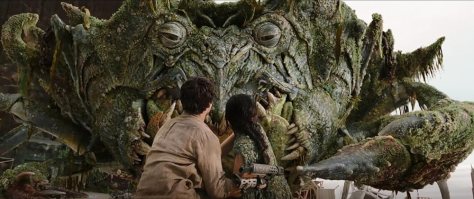
If Reign of Fire was a purely 2002 vision of the apocalypse, Love and Monsters is its late 2010s counterpart, the same basic story with a completely different approach. Where Reign loudly communicated its era by draining itself of colour and humour and having only vague self-awareness of the limitations of its CGI effects, L&M reflects its own by saturating itself with bright cartoon hues and quippy narration and CGI that has become so advanced and widespread that its generally seamless integration feels almost effortless (in fact, it received an Academy Award nomination for Effects.) The interesting contrast between these two movies might be further bolstered by eerie coincidence: Reign took place in a decimated world in 2020, while L&M was released in the midst of a decimated world in 2020, which mostly killed its theatrical run minus a few small-scale screenings and left it to become a perennial item in the Netflix back catalogue. In short, choosing to watch these two in close proximity definitely gave me even more to think about.
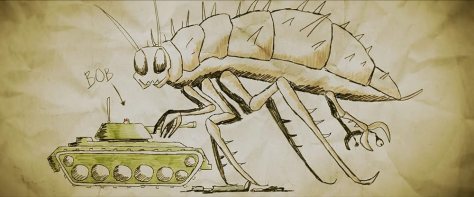
Quickly dispensing with a suitable enough explanation for why our world has been overtaken by nature and filled with throwback atomic monsters, the intro uses illustrations to show how a united world effort to repel an incoming asteroid with nuclear missiles had the side effect of showering the planet with radiation that turned common garden pests into giant-sized predators that reduced humanity to its bare minimum and forced them underground. The images come from the sketchbook of Joel (Dylan O’Brien), who witnessed the events as a teenager and saw the death of his parents as they attempted to escape the fallout; he now lives in one of the many bomb shelters that dot the landscape alongside a group of fellow survivors. Joel feels extraneous to the group: left out of the hunt for resources in the outside world because of his propensity to freeze up in fear, given the unrewarding task of heating up canned food and looking after their one cow, and most importantly, the only one who is not romantically paired off (the movie can be read as mostly heteronormative, but at least in this case there is literally no other person there for him to be paired.) His utter incompatibility with the situation is even rendered on pure genre visual terms: everyone else in the bunker looks and acts more like the cast of Reign of Fire, with him as the awkward nerd sitting in the corner as they fire crossbows at giant ravenous insects. After making contact with his old high school flame Aimee (Jessica Henwick) using a reconstructed radio and learning that she is stationed in a bunker along the California coast, he tells the rest of his group that he’s leaving to walk the eighty-plus miles to meet up with her—they alternate between dismissive and angry, but ultimately support his decision. In a meaner movie, it would be because everyone else views him as useless—and Joel himself seems to think that he is—but this is not a particularly mean movie.
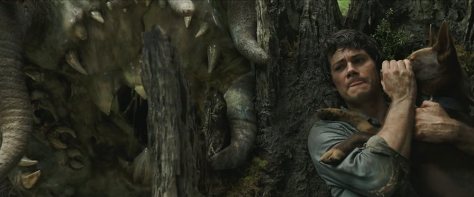

Coincidentally, I’ve written about another post-apocalyptic story where humans huddle in bunkers while giant mutant animals stomp around the rewilded surface: the animated Netflix series Kipo and the Age of Wonderbeasts, which also released in 2020. Something was certainly in the air, and the colourful depictions of familiar urban settings warped into monster realms has a similar vibe in both. Where L&M and South African director Michael Matthews find its most compelling vistas, though, is not in the by-now cliche sight of crumbling major cities and empty highways, but even more mundane suburban areas: rows of houses with recognizable backyards, playgrounds, motels, and trailer parks, with the signs of the outsize insect colonies and burrows carved into the surroundings. A giant toad emerging from your common decorative pond has a certain originality to it, and actually lives up to the post-apocalyptic fantasy of seeing your neighbourhood transformed into a danger-soaked fantasy world. Those details also smartly complement its decision to make its parade of distinctive monsters primarily out of (usually tiny) common creatures: alongside the toad, you will see giant leeches, a massive centipede, and colossal snails. It’s a bit like Them! being applied to every other garden denizen, and all of them are rendered with a good mix of realism and stylization and animated with personality (there are a few moments where they even use real life props!) In short, it’s a good execution of potentially overused ideas.
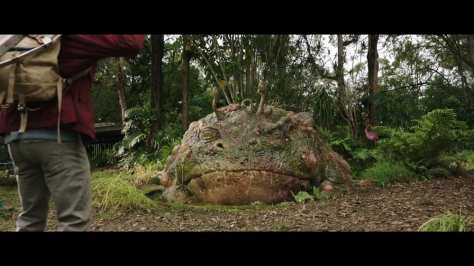

When it’s not primarily acting as a showcase for its mutant creature designs, the driving force behind the plot is to gradually teach Joel the benefits of community—which is not a long shot from the moral at the heart of numerous other stories of rebuilding society, but centralized into a single character’s vision of himself. Joel’s ceaseless little asides and self-aware commentary on just about everything could potentially grate on you in the way that overly-clever writing of the modern genre film can, and the movie’s attempts to frame it as mostly a coping mechanism can only go so far in justifying what is essentially just the standard mainstream tone of the era. More interesting is the story’s framing of Joel’s motivation, equal parts low self-esteem among a colony of more capable scavengers, a self-aggrandizing sense of being an outsider bucking against the entrenched system, and a nostalgic yearning to reconnect with some part of his pre-apocalypse past. He feels unimportant, so he’s taking part in what he himself calls a “grand romantic gesture” to give his life some meaning, but there’s something both selfish and sad about it. The erosion of his delusion comes at first with the slow gathering of short and long term allies: a hyper-competent dog named Boy who saves his skin multiple times but is also emotionally attached to a dress worn by his deceased owner, and then the found family of practical survivors Clyde (Michael Rooker) and Minnow (Ariana Greenblatt) who mock his inability to fire a crossbow, but take the time to teach him proper monster fighting techniques. Rooker is, of course, always game to play someone grizzled and sarcastic, but for all their survival focus and love of morbid jokes, Clyde and Minnow also provide some empathetic lessons, both by demonstrating how people can share knowledge to collectively improve their situation—even they learn a thing or two from Joel’s sketchbook of monsters—and by showing him that some of the mutants are not inherently bloodthirsty and can be dealt with peacefully. Joel and Boy eventually part ways with the other two, and the movie is confident enough to let them bow out without having them inexplicably rejoin the main story later—we do catch up with them by the end, though.

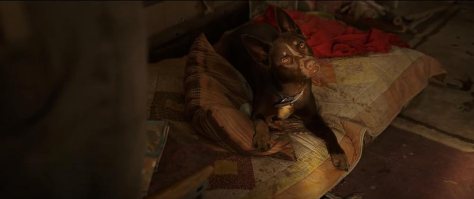
I wouldn’t call the attempts at humanism in between the monster thrills something beyond the usual for post-apocalyptic narratives, but I can still appreciate a movie of this type not succumbing to the cynical and violent inclinations of the genre, and even attempting moments of quieter pathos and beauty. An example of that is seen when Joel enters a motel room and finds a working robot—a MAV1S, apparently a sentient consumer product that was common before the Great Mutationing—and he has a pretty heartfelt conversation with it before its battery finally dies out, together bearing witness to a sky full of floating jellyfish. More than the way it uses comedy and action to leaven things, its thematic consistency is what helps prevents it from feeling like mere treacle: writers Brian Duffield (writer of Underwater, another monster movie victim of the pandemic, and the recent Netflix King Kong animated series Skull Island) and Matthew Robinson (one of the writers of the infamous train wreck Monster Trucks) make sure these scenes are there to reinforce Joel’s growing belief that humans can learn to live on the mutated surface, and to gradually help him learn to move forward with his own life—a realization that not only he needs to have, but his dog as well. Yes, the dog has a character arc.


Miraculously—but not unexpectedly—our protagonist does in fact reach Aimee’s colony, but her light recognition of his bravery in the name of the titular love (in the face of the titular monsters) very swiftly disabuses him of the notion that things are just going to go back to the way they were before. No, the seven years since the end of the world has left Aimee in a very different place, as she has essentially taken over as the caretaker of a colony of mostly older people and has, in the meantime, formed other close relationships in Joel’s absence. This is a blow to his ego is so devastating that Joel even briefly contradicts himself, arguing to remain sedentary when a trio of newcomers piloting a yacht offers the whole colony a chance to venture elsewhere—this seems to be at least partially motivated by the captain of the trio (Dan Ewing) being a handsome romantic rival. Of course, the yacht group turns out to be crooked, but in a twist that goes back to the movie’s more optimistic bent, the most potent weapon against an unexpected Attack of [a] Crab [Monster] is not his newly-discovered marksmanship, but his ability to show kindness to the inhuman.
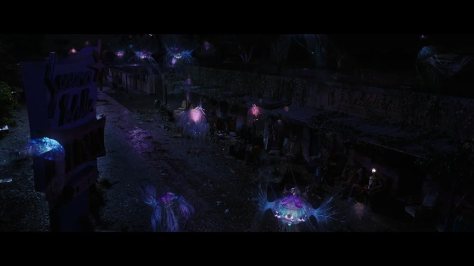
Being cured of his Protagonist Syndrome leads Joel to the two main takeaways of his ordeal: that he was wrong to think he needed to go solo (and attempt to recapture his past), and in the process learning to appreciate his own found family in the bunker; but also that he was correct for thinking that the survivors need to be more willing to brave the world as it is rather than hide away from it. When you write down like that, it is almost entirely the same conclusions that Christian Bale and Matthew McConaughey make at the climax of Reign of Fire. Clearly, this is a movie that does not really get away from the cliches I found in that movie, even eighteen years later and many fictional apocalypses later—but at the very least, it expresses them here in more certain and emotionally readable terms, without the layers of CGI ash and scowling and overdone action scenes to obfuscate it. In 2020—the real one, not the dragon invasion one—a monster movie like this maybe feels a bit more confident in being goofy and sentimental while creating a world filled with giant monsters.
